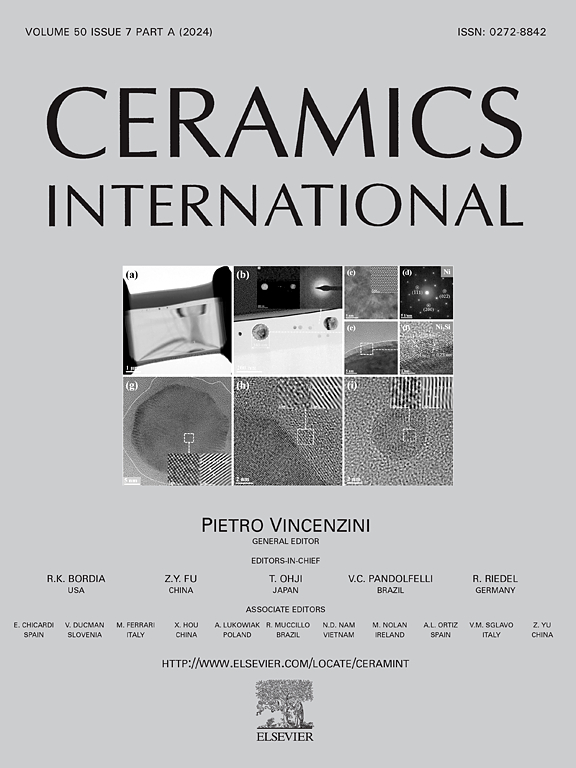Effect of the parameters of bimodal microstructure on the mechanical properties of alumina: A case of sintering regime effects
IF 5.6
2区 材料科学
Q1 MATERIALS SCIENCE, CERAMICS
引用次数: 0
Abstract
The effect of sintering regimes on the density, microstructure parameters, and mechanical properties of Al2O3 and Al2O3 + 0.25 % MgO ceramics has been investigated. The ceramics were sintered in three regimes: Regime I – heating at a constant rate (2.5, 5, 10, 20 °C⋅min−1) up to the temperature T = 1650 °C; Regime II – heating with a varied heating rate up to 1565 °C with the duration corresponding to sintering at the heating rate of 10 °C⋅min−1 in Regime I followed by a three-fold decrease in the shrinkage rate; Regime III – two-stage sintering: heating according to Regime II up to the temperature T1 = 1550 °C, then lowering the temperature down to T2 = 1300–1500 °C and holding for 3 h at the T2. The sintering regimes were chosen so that the ceramics had the relative density of 97–99 % and a bimodal distribution of the microstructure parameters. The Al2O3 and Al2O3 + 0.25 % MgO ceramics obtained in Regimes I–III had a microstructure with abnormally large grains in a fine-grained matrix. The sizes and volume fractions of the large grains depended on the sintering regime. Most abnormally large grains had elongated shapes that leads to deviations in the crack propagation trajectories from the straight line. The optimal parameters of the bimodal microstructure parameters distribution providing enhanced mechanical properties of the ceramics (hardness, indentation fracture toughness, ultimate strength) have been determined.
双峰结构参数对氧化铝力学性能的影响:以烧结制度影响为例
研究了烧结制度对Al2O3和Al2O3 + 0.25% MgO陶瓷的密度、微观结构参数和力学性能的影响。在三种状态下烧结陶瓷:状态一-以恒定速率(2.5、5、10、20°C·min−1)加热至温度T = 1650°C;状态II -升温速率为1565℃,持续时间与状态I中升温速率为10°C·min−1的烧结时间相对应,随后收缩率下降3倍;方案III -两段烧结:根据方案II加热至T1 = 1550℃,然后将温度降至T2 = 1300-1500℃,并在T2处保温3小时。烧结方式的选择使陶瓷的相对密度为97 ~ 99%,微观结构参数呈双峰分布。在I-III区制备的Al2O3和Al2O3 + 0.25% MgO陶瓷在细晶基体中具有异常大晶粒的微观结构。大晶粒的尺寸和体积分数取决于烧结状态。大多数异常大的晶粒具有拉长的形状,导致裂纹扩展轨迹偏离直线。确定了提高陶瓷力学性能(硬度、压痕断裂韧性、极限强度)的最佳双峰组织参数分布参数。
本文章由计算机程序翻译,如有差异,请以英文原文为准。
求助全文
约1分钟内获得全文
求助全文
来源期刊

Ceramics International
工程技术-材料科学:硅酸盐
CiteScore
9.40
自引率
15.40%
发文量
4558
审稿时长
25 days
期刊介绍:
Ceramics International covers the science of advanced ceramic materials. The journal encourages contributions that demonstrate how an understanding of the basic chemical and physical phenomena may direct materials design and stimulate ideas for new or improved processing techniques, in order to obtain materials with desired structural features and properties.
Ceramics International covers oxide and non-oxide ceramics, functional glasses, glass ceramics, amorphous inorganic non-metallic materials (and their combinations with metal and organic materials), in the form of particulates, dense or porous bodies, thin/thick films and laminated, graded and composite structures. Process related topics such as ceramic-ceramic joints or joining ceramics with dissimilar materials, as well as surface finishing and conditioning are also covered. Besides traditional processing techniques, manufacturing routes of interest include innovative procedures benefiting from externally applied stresses, electromagnetic fields and energetic beams, as well as top-down and self-assembly nanotechnology approaches. In addition, the journal welcomes submissions on bio-inspired and bio-enabled materials designs, experimentally validated multi scale modelling and simulation for materials design, and the use of the most advanced chemical and physical characterization techniques of structure, properties and behaviour.
Technologically relevant low-dimensional systems are a particular focus of Ceramics International. These include 0, 1 and 2-D nanomaterials (also covering CNTs, graphene and related materials, and diamond-like carbons), their nanocomposites, as well as nano-hybrids and hierarchical multifunctional nanostructures that might integrate molecular, biological and electronic components.
 求助内容:
求助内容: 应助结果提醒方式:
应助结果提醒方式:


